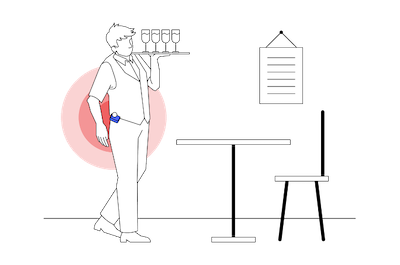
Restaurants in the United States employ about 14.5 million workers, a workforce that is projected to grow by 400,000 jobs by the end of this year. No matter the type of establishment they’re employed by, from fast food to fine dining, all restaurant workers face injury risks on the job.
A Recipe for Strains & Sprains
While the risks restaurant and fast food employees encounter are varied, including slips and falls, and cuts and burns, strains and sprains are among the most common. Heavy lifting and repetitive motion are often to blame. In the front of the house, lifting or balancing heavy trays of dishes, reaching across tables to serve customers, and moving tables and chairs for customer seating can cause injury to servers and bussers. For kitchen staff, lifting heavy boxes or bags of ingredients, and repetitive tasks like chopping, stirring, and kneading can lead to strain and sprain injuries and claims.
- It’s estimated restaurants and fast food employers paid out over $142 million in workers’ comp claims in 2019.
- Strain & sprain claims are a leading loss driver, representing almost 20% of all claims costs among restaurant and fast food workers.
(Source: NCCI data for Restaurants & Fast Food in 2019 )
Total strain and sprain claims cost more per claim than the average claim in the restaurant and fast food industry. And indemnity claims for strains and sprains are the most costly. According to the National Council on Compensation Insurance (NCCI) data for restaurants and fast food in 2019:
- the average workers’ compensation claim cost was $6,403
- the average strain & sprain claim cost was $9,162
- the average strain & sprain indemnity claim cost was $9,859
On-the-job injuries impact injured workers with pain and lost work time, and employers with lost productivity and potentially higher workers’ compensation insurance premiums.
Controlling Loss with Wearable Tech
One of the best ways to minimize workers’ compensation claims is to reduce the risk of injuries in the first place. While restaurant workers can be trained to recognize and avoid the risks they face each day, employers can also leverage tech-driven safety solutions such as wearables designed to specifically reduce the awkward postures and repetitive movements that lead to employee strain and sprain injuries.
When outfitted with wearable devices, workers can receive real-time alerts that drive sustained behavior change. With this continuous coaching method, employees can reduce their high-risk movements. In turn, they experience less soreness and fatigue, are able to keep their pace up for longer, miss less work, and experience greater emotional and mental well-being.
Beyond driving behavior change that leads to fewer worker injuries, wearable safety devices provide employers with new actionable data that reveal areas most at risk and allow companies to take proactive steps to reduce the risk. The resulting targeted training efforts and workspace or process redesigns lead to a further decrease in injuries.
Reduced injury rates reduce a policyholder’s overall workers’ comp burden. In environments where high strain and sprain injury rates are present, like in the restaurant and fast food industry, wearables can reduce claims costs by 50%. And with fewer claims reported, E-mod scores improve and premium rates go down. Tech-enabled risk prevention, such as a safety wearables program, is truly a win-win for all parties.
Kinetic Insurance, in partnership with Nationwide, is pioneering a technology-driven approach to worker safety that benefits insurance carriers, brokers, and policyholders. Our workers’ compensation offerings lower costs by equipping workers with wearable technology that is proven to reduce injuries by as much as 60% and lost work days by 72%. Want to learn more?
Inquire about being appointed with Kinetic Insurance or connect with our Broker Success Team at info@kinetic-insurance.com.
